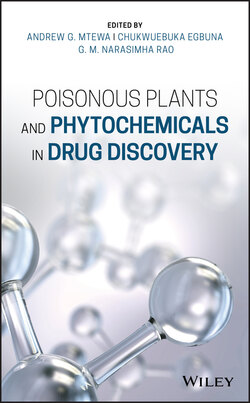Читать книгу Poisonous Plants and Phytochemicals in Drug Discovery - Группа авторов - Страница 16
1.2 Poisonous Plants as Sources of Traditional and Modern Medicines
ОглавлениеTraditional medicine has been the source of several modern drugs. Many well‐known poisonous plants are widely used in traditional medicine and are a source of life‐saving drugs [3, 9]. Nature produces a variety of toxic compounds, many of which have found applications as anticancer drugs [10]. The same toxic compounds can serve as therapeutic compounds depending on the dose administered. This fact is well articulated in Paracelsus’ dictum, which states that only the dose determines that a thing is not a poison [3]. Table 1.1 shows some common poisonous plants from which modern drugs have been obtained.
Several toxic compounds from plants belong to several classes of compounds, including alkaloids, glycosides, flavonoids, proteins, and saponins [1, 3, 25]. Most saponins can cause hemolysis of erythrocytes at doses of only a few milligrams per milliliter but may also have other toxic properties. Saponin‐containing plants are extensively used as fishing poisons. Alkaloids have extraordinary structural diversity and a wide variety of pharmacological activities, such as muscle relaxants and cardiovascular and respiratory agents [2, 3]. They belong to the most powerful plant constituents and are responsible for the activity of a host of poison ingredients. Flavonoids, which have a wide structural variety, show a broad range of activities but are rarely used as a primary source of toxicity for mammals, except for several compounds of special structure such as rotenoids, which are used for fish poisoning [3].
Table 1.1 Some common drugs derived from toxic plants.
| Name of plant | Toxic principles/drug(s) derived | Use of drug |
|---|---|---|
| Strychnos spp. | Strychnine | Neuropharmacological science [11] |
| Strophanthus spp. | Ouabain | Acute cardiac insufficiency [12, 13] |
| Strophanthus spp. | k‐Strophanthin | Acute cardiac insufficiency/cardiotonic research [12, 13] |
| Physostigma venenosum | Physostigmine | Glaucoma and myasthenia gravis [14, 15] |
| Chondrodendron tomentosum | D‐Tubocurarine | Muscle relaxant in anesthesia [14, 16] |
| Rauwolfia serpentina | Reserpine (Serpalan and Serpasil) | Antihypertensive and psychotropic [17, 18] |
| Rauwolfia vomitoria | Ajmaline | Cardiac arrhythmias [19] |
| Catharanthus roseus | Ajmaline | Cardiac arrhythmias [19] |
| Vincristine | Pediatric malignancies, acute lymphocytic leukemia, lymphoid blast crisis of chronic myeloid leukemia, and both Hodgkin’s and non‐Hodgkin’s lymphomas [14] | |
| Digitalis purpurea | Digitoxin | Tachyarrhythmia [14] |
| Taxus brevifolia | Taxol (docetaxel/Taxotere) | Ovarian, breast, and colon cancers and Kaposi's sarcoma [20] |
| Colchicum autumnale | Colchicine | Gout [21]; familial Mediterranean fever [22] |
| Melilotus officinalis/Melilotus albus | Dicoumarol (warfarin) | Thrombotic conditions [23] |
| Camptotheca acuminata | Camptothecin | Anticancer [20] |
| Podophyllum emodi/Podophyllum peltatum | Podophyllotoxin | Anticancer [5, 24] |
| Papaver somniferum | Morphine | Analgesic [14] |
| Erythroxylum coca | Cocaine (benzoylmethylecgonine) | Local anesthetic [14] |
| Atropa belladonna Datura stramonium Hyoscyamus niger Hyoscyamus muticus | Scopolamine | Prevention of motion sickness and postoperative nausea and vomiting; parkinsonism; ophthalmic treatment [14] |
Almost all the active ingredients of African arrow poison come from plants. At least 80% of the poisons are based on cardioactive components, mostly cardiac glycosides from the genera Acokanthera, Parquetina, and Strophanthus. Other genera with numerous poisonous species are Adenium, Mansonia, Calotropis, Pergularia, Corchorus, Erythrophleum, Euphorbia, Gnidia, and Jatropha [3]. Many other plant toxins used have a variety of activities, but their toxic effects are more long term than acute, e.g. sesquiterpene lactones, iridoids, pyrrolizidine alkaloids, and tannins. Some alkaloid‐bearing plants that are used as base poisons include Strychnos spp., Boophone disticha, Crinum spp., Triclisia dictyophylla, Nicotiana spp., Physostigma venenosum, Sarcocephalus latifolius, and Erythrophleum spp. [3, 26].
Some medicinal plant species used in African traditional medicine have potential or well‐known toxicities. However, some of the toxic effects of plants are not easy to discern because they are either subacute or chronic. This is compounded by the fact that very few African plants have been tested for toxicity. Tamokou and Kuete [27] evaluated 120 African medicinal plants that had been previously screened for their toxic effects and found that about 40% of them were potentially toxic, with symptoms affecting neurological, hepatic, renal, gastrointestinal, and cardiovascular systems.
